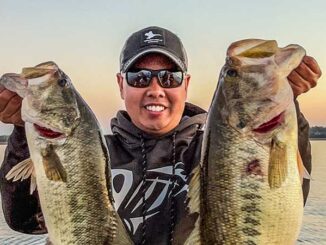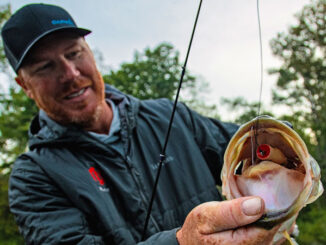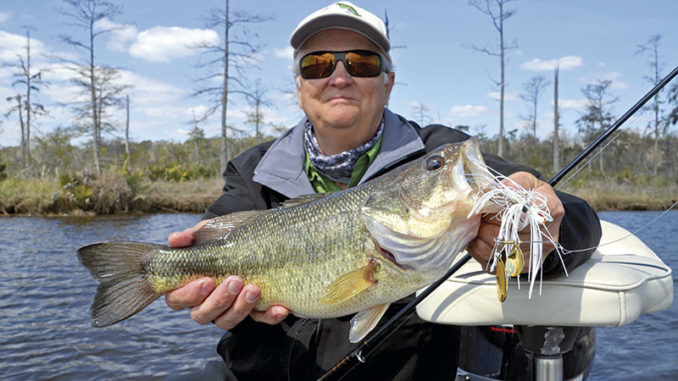
More than 5,000 miles of rivers, bayous and creeks, not to mention lakes and other waterbodies, traverse through the Sportsman’s Paradise.
Unlike reservoirs, rivers constantly change, tearing down, building up and reconfiguring themselves. They change course, isolating backwaters, filling in flats, building sandbars or slashing new channels. Water regularly rises and falls.
“A major thunderstorm upstream could turn a river into raging torrent downstream almost overnight,” said Richard Williams, a fisheries biologist for the Louisiana Department of Wildlife and Fisheries. “Whenever the current gets stronger, it can muddy the system, making fishing tough. We call it a flood pulse. On the plus side, that flood pulse brings in new nutrients and baitfish that keeps the system healthy. High water can recharge and restock the oxbows and backwaters with fish.”
Rivers typically flow at their lowest and clearest levels in the fall. As days turn a little cooler and shorter, bass fatten up on shad before the winter. They frequently attack shad schools. Find the shad and find the bass.
“As temperatures start falling, fish pull off the main river channels and start hitting the secondary points and cuts going into the backwaters,” said Dakota Fleming, a bass pro from Oak Grove in West Carroll Parish. “Bass follow the shad back into that shallower water. When grass starts dying off, I’ll switch to fishing woody cover like stumps, trees and laydowns.”
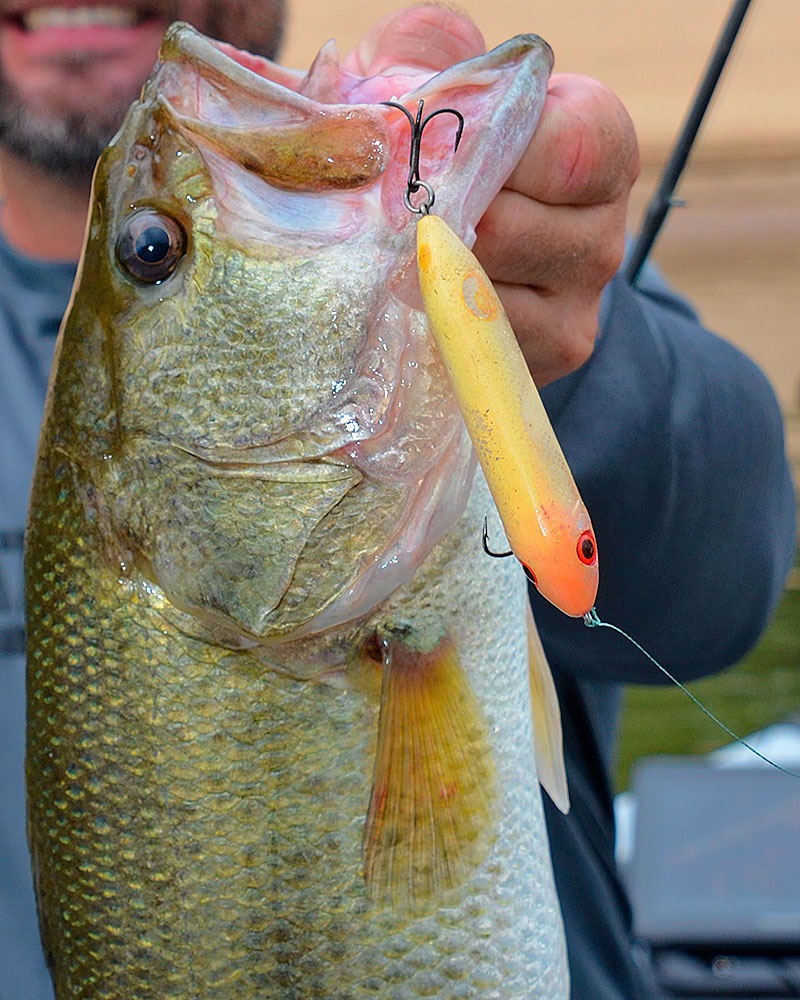
Tempt them with topwaters
Topwater baits make excellent and exciting offerings for tempting schooling bass. For sheer exhilaration, nothing in fresh water compares to a big, hungry largemouth ferociously smashing a topwater temptation. When temperatures cool, bass remain active longer and might hit topwaters all day long.
“In October, I throw topwaters and spinnerbaits,” said Kevin Lasyone, a tournament angler from Dry Prong. “I like to throw poppers right up against the cover. I’ll work it really slow, pop it three or four times and stop. Then repeat. For colors, I prefer a baby bass or shad pattern in the fall. For spinnerbaits, I like a ¼-ounce blue, chartreuse and white Humdinger with an Indiana or willow-leaf blade. Some people put a white twin-tail trailer on it.”
Jerkbaits also produce excellent action in the fall. Some jerkbaits float and others suspend or slowly sink. Long, slender minnow-like jerkbaits with small lips dive and wobble enticingly when an angler jerks the rod. When fishing floaters, pop the rod to disrupt the surface so the bait dives a foot or two. Then, pause the retrieve so the lure floats back to the surface. Anglers can also reel jerkbaits slowly and steadily to create an erratic, wobbling action just below the surface.
“I love fishing jerkbaits,” said Randy Howell, a former Bassmaster Classic champion. “I use them when the water starts to cool and fish start chasing baitfish, but they are effective all year long. They’re extremely versatile lures that can be fished in many different situations. Jerkbaits are very good for targeting non-active fish and provoking reaction strikes.”
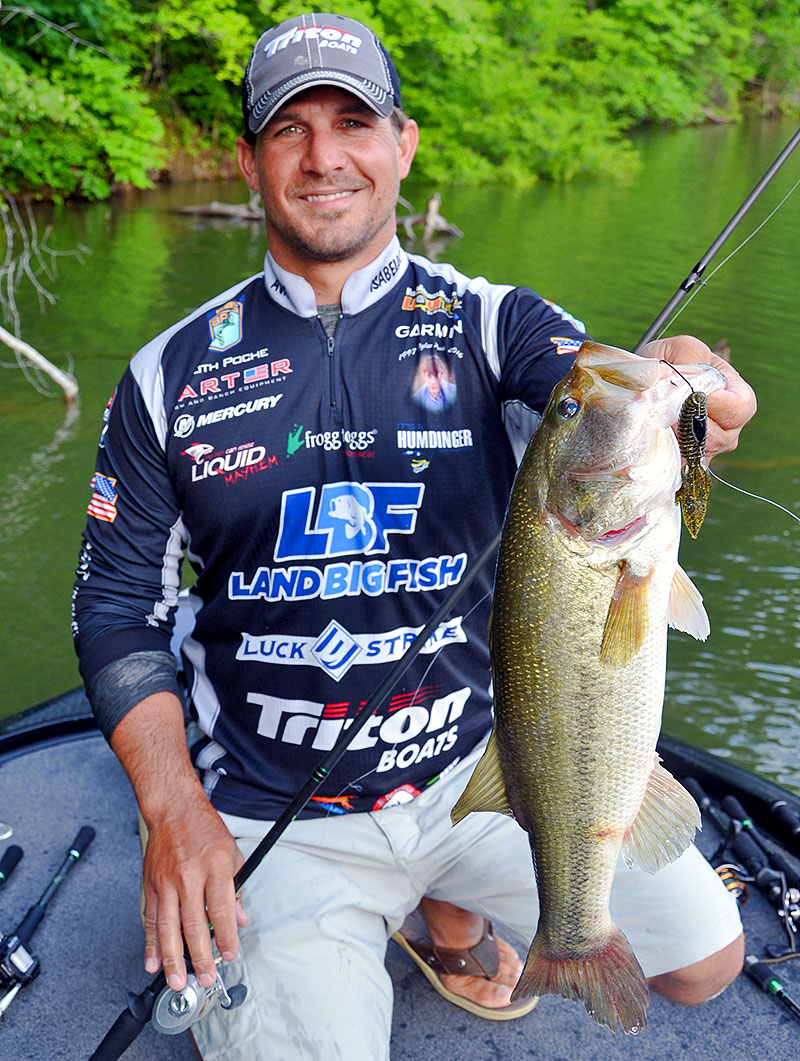
Current makes it easy
If anglers can’t find schooling bass, they must look where bass want to stay. Current creates slack spots. Almost always, bass stay in that slack water, but face upstream waiting to ambush anything that washes toward them. Facing into the current also gives bass an energy boost as more dissolved oxygen rushes through their gills.
“Current positions fish and makes them easier to find,” Lasyone said. “With a strong trolling motor, we can face upstream and move slowly forward with more control than when drifting downstream. About 90 percent of the time, I throw jigs. The key is throwing past where bass are and running the bait down to them. Keep the line tight and let the bait swim down with the current. As soon as it comes across a limb, log or other current break, drop the rod tip to let the bait sink straight down into that slack water behind the current break. That way, the bait falls right down in front of the fish and they can’t resist it.”
A bend slows down the current on the inside side and speeds it up on the outside. Sandbars usually form where the flow weakens sufficiently to let suspended silt fall to the bottom. Weeds normally grow in placid waters downstream of the sandbars, making good places to throw frogs, topwaters, spinnerbaits or crankbaits.
“A swing in the river channel can create an eddy,” Fleming said. “That’s usually where largemouth sit. I like to cover water early in the morning, so I start with a buzzbait to see if the fish are active. I might also throw a spinnerbait. A little later, I’ll throw a shad-pattern square-billed crankbait. I almost try to get it hung on a snag. I want to get the crankbait right up against the wood or along bushes. A chrome and blue Rat-L-Trap is another bait that’s very effective in the fall.”
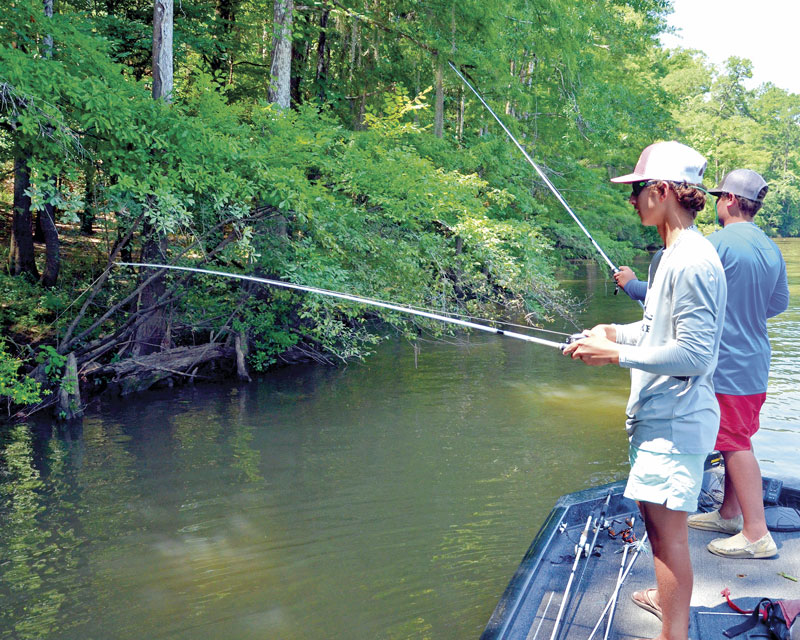
Shallow ends
Along the opposite bank, water must travel farther in the same amount of time, so it goes faster. Powerful currents scour deeper holes. Water depth can plunge rapidly. Logs and other debris carried by the current might fall into these holes, creating additional bass cover. Fish the outside bends with Texas-rigged worms, jigs or crankbaits. Throw a Carolina rig up shallow and work it out to the deepest water.
“When fishing a river with current, I fish the shallows at each end of the bend,” Lasyone said. “Most bass will be on the upstream side where a ledge drops into deep water. I’ll throw a 3/8-ounce V&M Sneaky Snake jig with a green pumpkin Speed Craw trailer on the ledge and drag it off into deeper water or swim it around the logs and other cover. I’ll also fish the bluff part of the bend with a jig.”
On major rivers like the Red, rock or concrete wing dams periodically redirect currents to keep channels swept clean of silt. Mud builds up behind the dams, creating shelves and fostering vegetation growth. Current sweeping around the dam tips scours holes where bass can escape the current.
“If the current is strong, bass will be on the downstream side,” Lasyone said. “They could be close to the bank when the current is really strong. I get on the downstream side and start by the shoreline. I work out toward deeper water with a shad-pattern square-bill crankbait. Sometimes, I swim a jig around the rocks.”
Louisiana sportsmen find abundant streams to fish everywhere within an easy drive from home. Some better rivers include the Black, Cane, Ouachita, Pearl, Sabine, Tickfaw and the Atchafalaya Basin. Cypress trees line many rivers and aquatic vegetation grows thick.
“When fishing a riverbank with cypress growing in the water, it’s hard to beat a buzzbait for bass quality,” Fleming said. “If that doesn’t work, throw a crankbait next to the trees. For non-aggressive bass, I’ll flip a jig, creature bait or fish a Senko. On a grassy shoreline, I’ll throw a solid white swim jig. Around lily pads, I’d run a frog over the tops or a weedless swimbait with a belly weight hook. A ChatterBait can also come through stems fairly well.”
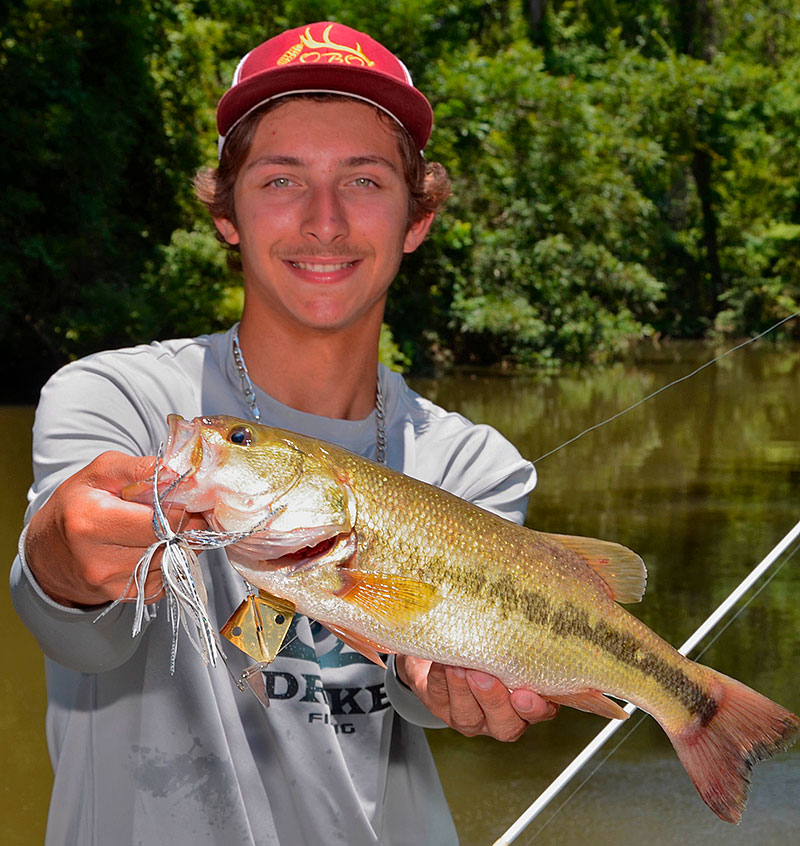
More than ducks
Ordinarily, Louisiana sportsmen think of Catahoula Lake as a duck hunting paradise. Each year, the state floods this natural low spot in LaSalle and Rapides Parishes before duck season. In the summer, the state drains the lake through the Little River so grasses can sprout for duck food.
“When the state opens the locks to drain Catahoula Lake, we get in the current breaks on Little River and smoke the bass,” Lasyone said. “We can do this all the way into October. Once the lake gets low, fish will hang out in the slough mouths where fresh, cool water comes into Little River and in deeper river bends.”
Coastal rivers like the Pearl, Sabine and the Mississippi Delta flow through brackish marshes. In these delta marshes, anglers commonly catch bass, redfish, flounder and other salty fish at the same time with the same baits.
Except in the Red River, really five impoundments now, anglers won’t likely land double-digit bucketmouths, but the incredibly fertile Louisiana rivers and bayous can produce great bass numbers. What river bass lack in size they compensate with a pugnacious attitude from living in such a dynamic environment and strength forged by fighting currents. The state collects data on various waters from bass tournaments for the Louisiana Annual Tournament Report Information Project (LATRIP).
“According to the 2022 LATRIP surveys, Pearl River did really well for numbers that year,” Williams said. “Among rivers, Cane River ranked really well for larger bass. The average weight for big bass in a Cane River tournament was 4.5 to five pounds.”
As water temperatures begin to cool, most pleasure boaters disappear from the rivers. In the fall, hunters head to the forests and fields to pursue their favorite game. Then, bass anglers can fish the hottest honey holes with little pressure at one of the best times to fish.
Anglers can review the data on many waterbodies at www.wlf.louisiana.gov.

